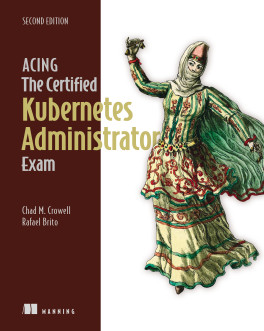pro $24.99 per month
- access to all Manning books, MEAPs, liveVideos, liveProjects, and audiobooks!
- choose one free eBook per month to keep
- exclusive 50% discount on all purchases
- renews monthly, pause or cancel renewal anytime
lite $19.99 per month
- access to all Manning books, including MEAPs!
team
5, 10 or 20 seats+ for your team - learn more

Safely manage your secret information like passwords, keys, and certificates in Kubernetes. This practical guide is full of best practices and methods for adding layers of security that will defend the critical data of your applications.
In Kubernetes Secrets Management you will find:
Secrets, like database passwords and API keys, are some of the most important data in your application. Kubernetes Secrets Management reveals how to store these sensitive assets in Kubernetes in a way that’s protected against leaks and hacks. You’ll learn the default capabilities of Kubernetes secrets, where they’re lacking, and alternative options to strengthen applications and infrastructure. Discover a security-first mindset that is vital for storing and using secrets correctly, and tools and concepts that will help you manage sensitive assets such as certificates, keys, and key rotation.
In Kubernetes Secrets Management you will find:
- Strategies for storing secure assets in Kubernetes
- Cryptographic options and how to apply them in Kubernetes
- Using the HashiCorp Vault server on Kubernetes for secure secrets storage
- Managing security with public cloud providers
- Applying security concepts using tools from the Kubernetes ecosystem
- End-to-end secrets storage from development to operations
- Implementing in Kubernetes in CI/CD systems
Secrets, like database passwords and API keys, are some of the most important data in your application. Kubernetes Secrets Management reveals how to store these sensitive assets in Kubernetes in a way that’s protected against leaks and hacks. You’ll learn the default capabilities of Kubernetes secrets, where they’re lacking, and alternative options to strengthen applications and infrastructure. Discover a security-first mindset that is vital for storing and using secrets correctly, and tools and concepts that will help you manage sensitive assets such as certificates, keys, and key rotation.
about the technology
Kubernetes relies on passwords, tokens, keys, certificates, and other sensitive information to keep your system secure. But how do you keep these “secrets” safe? In this concise, practical book you’ll learn secrets management techniques that go far beyond the Kubernetes defaults.about the book
Kubernetes Secrets Management reveals security best practices and reliable third-party tools for protecting sensitive data in Kubernetes-based systems. In this focused guide, you’ll explore relevant, real-world examples like protecting secrets in a code repository, securing keys with HashiCorp Vault, and adding layers to maintain protection after a breach. Along the way, you’ll pick up secrets management techniques you can use outside Kubernetes, as well.what's inside
- Cryptographic options you can apply in Kubernetes
- Managing security with public cloud providers
- Secrets storage, from development to production
- End-to-end Kubernetes secrets management in CI/CD systems
One of the most important topics left out by all Kubernetes introductions—how to keep secrets secret. This is the best book to understand this complicated topic.
This book belongs on the shelf of every smart Kubernetes administrator or developer.
Excellent! A must-read resource for security and cloud architects.
Contains practical examples on how to utilize files or literal strings, package them into secrets, and use an API to construct objects on the cluster server.
choose your plan
team
monthly
annual
$49.99
$499.99
only $41.67 per month
- five seats for your team
- access to all Manning books, MEAPs, liveVideos, liveProjects, and audiobooks!
- choose another free product every time you renew
- choose twelve free products per year
- exclusive 50% discount on all purchases
- renews monthly, pause or cancel renewal anytime
- renews annually, pause or cancel renewal anytime
-
![]() Kubernetes Secrets Management ebook for free
Kubernetes Secrets Management ebook for free
choose your plan
team
monthly
annual
$49.99
$499.99
only $41.67 per month
- five seats for your team
- access to all Manning books, MEAPs, liveVideos, liveProjects, and audiobooks!
- choose another free product every time you renew
- choose twelve free products per year
- exclusive 50% discount on all purchases
- renews monthly, pause or cancel renewal anytime
- renews annually, pause or cancel renewal anytime
-
![]() Kubernetes Secrets Management ebook for free
Kubernetes Secrets Management ebook for free
choose your plan
team
monthly
annual
$49.99
$499.99
only $41.67 per month
- five seats for your team
- access to all Manning books, MEAPs, liveVideos, liveProjects, and audiobooks!
- choose another free product every time you renew
- choose twelve free products per year
- exclusive 50% discount on all purchases
- renews monthly, pause or cancel renewal anytime
- renews annually, pause or cancel renewal anytime
-
![]() Kubernetes Secrets Management ebook for free
Kubernetes Secrets Management ebook for free


















 Kubernetes Secrets Management ebook for free
Kubernetes Secrets Management ebook for free